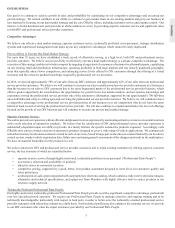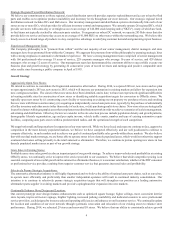O'Reilly Auto Parts 2014 Annual Report Download - page 20
Download and view the complete annual report
Please find page 20 of the 2014 O'Reilly Auto Parts annual report below. You can navigate through the pages in the report by either clicking on the pages listed below, or by using the keyword search tool below to find specific information within the annual report.
FORM 10-K
13
15(d) of the Securities Exchange Act of 1934, as amended, through the Securities and Exchange Commission website at www.sec.gov
and searching with our ticker symbol "ORLY." Such reports are generally available the day they are filed. Upon request, we will furnish
interested readers a paper copy of such reports free of charge by contacting Mark Merz, Director of External Reporting and Investor
Relations, at 233 South Patterson Avenue, Springfield, Missouri, 65802.
Item 1A. Risk Factors
Our future performance is subject to a variety of risks and uncertainties. Although the risks described below are the risks that we believe
are material, there may also be risks of which we are currently unaware, or that we currently regard as immaterial based upon the
information available to us that later may prove to be material. Interested parties should be aware that the occurrence of the events
described in these risk factors, elsewhere in this Form 10-K and in our other filings with the Securities and Exchange Commission could
have a material adverse effect on our business, operating results and financial condition. Actual results, therefore, may materially differ
from anticipated results described in our forward-looking statements.
Deteriorating economic conditions may adversely impact demand for our products, reduce access to credit and cause our customers
and others with which we do business to suffer financial hardship, all of which could adversely impact our business, results of
operations, financial condition and cash flows.
Although demand for many of our products is primarily non-discretionary in nature and tend to be purchased by consumers out of necessity,
rather than on an impulse basis, our sales are impacted by constraints on the economic health of our customers. The economic health of
our customers is affected by many factors, including, among others, general business conditions, interest rates, inflation, consumer debt
levels, the availability of consumer credit, currency exchange rates, taxation, fuel prices, unemployment levels and other matters that
influence consumer confidence and spending. Many of these factors are outside of our control. Our customers' purchases, including
purchases of our products, could decline during periods when income is lower, when prices increase in response to rising costs, or in
periods of actual or perceived unfavorable economic conditions. If any of these events occur, or if unfavorable economic conditions
challenge the consumer environment, our business, results of operations, financial condition and cash flows could be adversely affected.
Overall demand for products sold in the automotive aftermarket is dependent upon many factors including the total number of vehicle
miles driven in the U.S., the total number of registered vehicles in the U.S., the age and quality of these registered vehicles and the level
of unemployment in the U.S. Adverse changes in these factors could lead to a decreased level of demand for our products, which could
negatively impact our business, results of operations, financial condition and cash flows.
In addition, economic conditions, including decreased access to credit, may result in financial difficulties leading to restructurings,
bankruptcies, liquidations and other unfavorable events for our customers, suppliers, logistics and other service providers and financial
institutions that are counterparties to our credit facilities. Also, the ability of these third parties to overcome these difficulties may increase.
If third parties, on whom we rely for merchandise, are unable to overcome difficulties resulting from the deterioration in economic
conditions and provide us with the merchandise we need, or if counterparties to our credit facilities do not perform their obligations, our
business, results of operations, financial condition and cash flows could be adversely affected.
The automotive aftermarket business is highly competitive, and we may have to risk our capital to remain competitive.
Both the DIY and professional service provider portions of our business are highly competitive, particularly in the more densely populated
areas that we serve. Some of our competitors are larger than we are and have greater financial resources. In addition, some of our
competitors are smaller than we are, but have a greater presence than we do in a particular market. We may have to expend more resources
and risk additional capital to remain competitive. For a list of our principal competitors, see the "Competition" section of Item 1 of this
annual report on Form 10-K.
We are sensitive to regional economic and weather conditions that could impact our costs and sales.
Our business is sensitive to national and regional economic and weather conditions and natural disasters. Unusually inclement weather,
such as significant rain, snow, sleet, freezing rain, flooding, seismic activity and hurricanes, has historically discouraged our customers
from visiting our stores during the affected period and reduced our sales, particularly to DIY customers. Extreme weather conditions,
such as extreme heat and extreme cold temperatures, may enhance demand for our products due to increased failure rates of our customers'
automotive parts, while temperate weather conditions may have a lesser impact on failure rates of automotive parts. In addition, our
stores and DCs located in coastal regions may be subject to increased insurance claims resulting from regional weather conditions and
our results of operations, financial condition and cash flows could be adversely affected.
We cannot assure future growth will be achieved.
We believe that our ability to open additional, profitable stores at a high growth rate will be a significant factor in achieving our growth
objectives for the future. Our ability to accomplish our growth objectives is dependent, in part, on matters beyond our control, such as
weather conditions, zoning and other issues related to new store site development, the availability of qualified management personnel
and general business and economic conditions. We cannot be sure that our growth plans for 2015 and beyond will be achieved. Failure
























